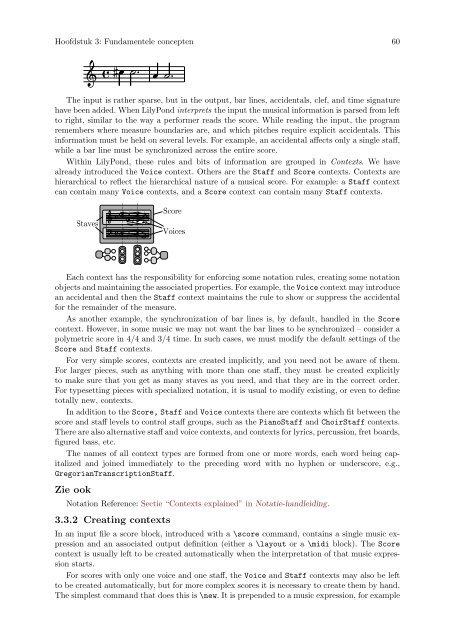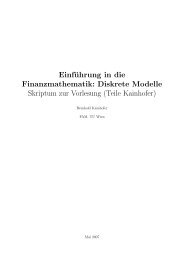LilyPond Beginnershandleiding
LilyPond Beginnershandleiding
LilyPond Beginnershandleiding
Create successful ePaper yourself
Turn your PDF publications into a flip-book with our unique Google optimized e-Paper software.
Hoofdstuk 3: Fundamentele concepten 60<br />
<br />
<br />
The input is rather sparse, but in the output, bar lines, accidentals, clef, and time signature<br />
have been added. When <strong>LilyPond</strong> interprets the input the musical information is parsed from left<br />
to right, similar to the way a performer reads the score. While reading the input, the program<br />
remembers where measure boundaries are, and which pitches require explicit accidentals. This<br />
information must be held on several levels. For example, an accidental affects only a single staff,<br />
while a bar line must be synchronized across the entire score.<br />
Within <strong>LilyPond</strong>, these rules and bits of information are grouped in Contexts. We have<br />
already introduced the Voice context. Others are the Staff and Score contexts. Contexts are<br />
hierarchical to reflect the hierarchical nature of a musical score. For example: a Staff context<br />
can contain many Voice contexts, and a Score context can contain many Staff contexts.<br />
Each context has the responsibility for enforcing some notation rules, creating some notation<br />
objects and maintaining the associated properties. For example, the Voice context may introduce<br />
an accidental and then the Staff context maintains the rule to show or suppress the accidental<br />
for the remainder of the measure.<br />
As another example, the synchronization of bar lines is, by default, handled in the Score<br />
context. However, in some music we may not want the bar lines to be synchronized – consider a<br />
polymetric score in 4/4 and 3/4 time. In such cases, we must modify the default settings of the<br />
Score and Staff contexts.<br />
For very simple scores, contexts are created implicitly, and you need not be aware of them.<br />
For larger pieces, such as anything with more than one staff, they must be created explicitly<br />
to make sure that you get as many staves as you need, and that they are in the correct order.<br />
For typesetting pieces with specialized notation, it is usual to modify existing, or even to define<br />
totally new, contexts.<br />
In addition to the Score, Staff and Voice contexts there are contexts which fit between the<br />
score and staff levels to control staff groups, such as the PianoStaff and ChoirStaff contexts.<br />
There are also alternative staff and voice contexts, and contexts for lyrics, percussion, fret boards,<br />
figured bass, etc.<br />
The names of all context types are formed from one or more words, each word being capitalized<br />
and joined immediately to the preceding word with no hyphen or underscore, e.g.,<br />
GregorianTranscriptionStaff.<br />
Zie ook<br />
Notation Reference: Sectie “Contexts explained” in Notatie-handleiding.<br />
3.3.2 Creating contexts<br />
In an input file a score block, introduced with a \score command, contains a single music expression<br />
and an associated output definition (either a \layout or a \midi block). The Score<br />
context is usually left to be created automatically when the interpretation of that music expression<br />
starts.<br />
For scores with only one voice and one staff, the Voice and Staff contexts may also be left<br />
to be created automatically, but for more complex scores it is necessary to create them by hand.<br />
The simplest command that does this is \new. It is prepended to a music expression, for example



